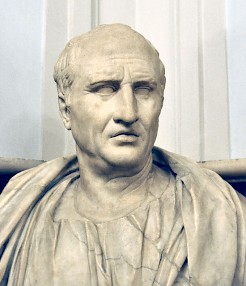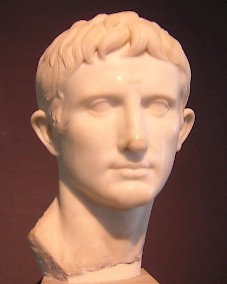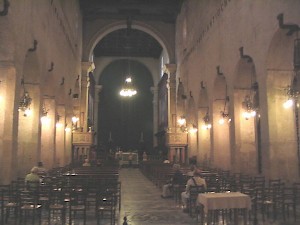History of Syracuse (6)
Q1954223Syracuse: the ancient capital of Sicily.
Roman Province
Since the First Punic War, most of Sicily was part of the Roman empire; the Second Punic War added Syracuse. In c.200, any intelligent observer would have been able to see that Rome, with its aggressive mentality and limitless resources of manpower, would one day unite the entire Mediterranean. Indeed, Sicily remained Roman until the Ostrogoths conquered Italy in the early sixth century. Syracuse shared the fate of the island, but was economically prosperous. The eternal movement between tyranny and democracy came to an end: the Romans preferred an oligarchy, and Syracuse was from now on ruled by a supreme magistrate who was at the same time priest of Zeus.
Sicily prospered, and could be exploited by the two quaestores (one in Lilybaeum, one in Syracuse). Senators exploited the island as well, in the form of large plantations (latifundia). They produced grain that was exported to Rome. Work was done by large numbers of slaves - often prisoners of war belonging to the same ethnic group: e.g., Celtiberians, Syrians, or Thracians. They were permitted to venerate their own gods and could speak their native language, so they were able to organize resistance against their owners without the Romans being aware. In 136 or 135, a man named Eunus was able to provoke an insurrection and seized the city of Henna in central Sicily. The story was repeated in 104-101, when Salvius Trypho and Athenio revolted. Roman armies made an end to the insurrections, and the exploitation continued.

One of the most notorious exploiters was a governor named Verres. He had taxed the province even more ruthlessly than his predecessors but made the mistake to include a client of the powerful general Pompey among his victims. In the early summer of 70, the Sicilians asked help from a relatively unknown lawyer, Marcus Tullius Cicero. Verres, supported by the powerful clan of the Metellii, hired the best advocate of his age, Hortensius, and a legal duel started. At that moment, Pompey was consul (together with Crassus), and Hortensius tried to postpone the case to 69. However, Cicero visited Syracuse (taking special care to find the neglected tomb of Archimedes) and was able to gather lots of evidence in only a couple of weeks. After his first thundering speech, Hortensius abandoned his brief, Verres went into exile, and no Roman senator was able to ignore that some reform in the provinces was necessary.
The Senate was divided on the nature of these reforms. Among the radical reformers was Julius Caesar, who, as consul, renewed the tax-laws in 59, demanding a fixed tribute. However, there was much obstruction and Caesar's increasing power after his wars in Gaul created resentment. Civil war broke out between Pompey and Caesar, and, after the death of Caesar, his adherents (Mark Antony, Lepidus, Octavian - the Second Triumvirate) successfully waged war against his murderers (Brutus and Cassius). Because Sicily was of great strategic value - Rome lived on Sicilian grain - the Caesarians gave the Sicilians full Roman rights, just to be sure that they remained loyal. This was a remarkable act, because most Sicilians spoke Greek and did not think of themselves as Italians or Romans. Yet, the priviliges were there.
But the days of Greek Sicily were over. During the conflict between the triumvirs and Caesar's murderers, a son of Pompey, Sextus Pompeius, seized power in Sicily and started to gather senators who wanted to overthrow the military leaders. The island became a pirate's nest, and Sextus Pompeius pretended he was protected by the sea god Neptune. However, Octavian, his admiral Marcus Vipsanius Agrippa, and Lepidus defeated Sextus Pompeius, and Octavian immediately stripped Lepidus of his powers (in 36). The island suffered terribly. Messana was sacked and large tracts of land were confiscated by Octavian.

Once again, Sicily had played an important role in Mediterranean history. From now on, it was obvious that Octavian would become sole ruler of the Roman world. He had defeated Caesar's murderers, had defeated the last senators, had defeated Lepidus. Only Mark Antony was still there, and he was defeated in 31 at Actium. Octavian, now sole ruler and calling himself Augustus, reorganized the empire, which meant that the government of the provinces was improved. From now on, Sicily was a senatorial province without legions, and the governor was a proconsul with praetorian powers. Syracuse received the rank of colonia.
Now, Sicily started to change. Until then, it had been part of the Greek world, but now people started to speak Latin. Official inscriptions were increasingly written in that language, it was used on coins, and people wanted to be buried in tombs with Latin epitaphs. The island still sold grain to Rome, and could also export wool, timber, and wine. The money was invested in new buildings, especially in the cities along the coast, and many monuments now to be seen date back to this period: in Syracuse, for example, an amphitheater was built for gladiatorial contests. At the same time, the towns in the interior of Sicily were converted into large villas, occupied by senators, whose presence was no longer needed in imperial Rome. Other parts of the island became imperial estates and domains. A procurator took care of them.
The Roman Empire had come to rest after the civil wars; it had become a monarchy. Sicily had lost its independence and became formally a part of Italy. Its history also became part of Italian history. Important decisions were no longer taken in its cities, and the island more or less disappears from our sources. It is archaeology that informs us that the Syracusans transformed the market in a Roman-style forum, that a bathhouse was built, and that marble was increasingly often used as building material.
The ancient population groups, once violently rivalling, lived together more harmoniously than ever. On Sicily, there were still people who spoke Phoenician, there were Greeks, and there were Romans, and they influenced each other in the most positive way. Sicilians are found as traders as far away as Xanten in Germania Inferior, and on the other hand, easterners settled in Syracuse: we find diasporic Jews, Samaritans, and Christians at an early stage - the first catacombs date back to the third century.
Except for an attack by a group of Frankish pirates, who captured Syracuse during the reign of the emperor Probus,note Sicily was only indirectly threatened by the military problems that Rome had to cope with in the third and fourth centuries. The Germanic tribes and the Sasanians were far away, and even if they broke through, they were no sailors and the island usually remained safe. It is no coincidence that the soldiers' cult of the god Mithras is almost absent from Sicily.
Change started late, in the fifth century. In the 430s, the Vandals crossed from [V]Andalusia to the Maghreb and captured Carthage, where they became notorious pirates who often raided Sicily. The decline of the Roman Empire now reached Sicily - with two centuries delay.
After 440, Sicily was occupied by the Vandals, but later, it was occupied and protected by east-Roman (or Byzantine) forces, while Italy was taken over by the Ostrogoths, led by their king Theodoric, a civilized man who tried to keep the Roman civilization alive. Except for Lilybaeum in the far west of Sicily, which was a stronghold of the Vandals, the island became part of Theodoric's kingdom, but it was later reconquered by the Byzantine general Belisarius (in 535).

The new ruler of Italy and Sicily was the emperor Justinian, who initiated a conscious policy of re-hellenization that was continued by his successors. With administrative and ecclesiastical measures, the Byzantine emperors tried to create cultural and religious unity in their territories. They spent lots of money in Syracuse and Catania, which became important centers of the Byzantine civilization.
Bishop Zosimus of Syracuse (649-c.660) was able to rebuild the Temple of Athena as a church, dedicated to the Holy Virgin. Inscriptions from this age show the Greek language again; perhaps it was reintroduced as a new language on a Latin island, or perhaps a still extant language was revitalized. For a while, from 663 to 668, Syracuse was even seat of the Byzantine government of the emperor Constans II.
In the mid-seventh century, when the Muslims had conquered northern Africa, Sicily was again threatened by raiders. The cities along the coast changed into fortresses, and the population moved to the interior. The Arabs invaded Sicily in 827. The Byzantine authorities were divided, and Palermo was taken in 831, Messina in 843, Syracuse in 877, and Taormina in 902. This marked the end of "classical" Sicily, and the beginning of a new age in which the island was a zone of cultural contact - this time between Islam and Christianity.